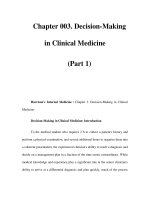Chapter 064. The Practice of Genetics in Clinical Medicine (Part 4) potx
Bạn đang xem bản rút gọn của tài liệu. Xem và tải ngay bản đầy đủ của tài liệu tại đây (62.43 KB, 5 trang )
Chapter 064. The Practice of Genetics
in Clinical Medicine
(Part 4)
Figure 64-2
Many disorders exhibit the feature of locus heterogeneity, which refers to
the fact that mutations in different genes can cause phenotypically similar
disorders. For example, osteogenesis imperfecta (Chap. 357), long QT syndrome
(Chap. 226), muscular dystrophy (Chap. 382), homocystinuria (Chap. 358),
retinitis pigmentosa (Chap. 29), and hereditary predisposition to colon cancer
(Chap. 87) or breast cancer (Chap. 86) can each be caused by mutations in distinct
genes. The pattern of disease transmission, clinical course, and treatment may
differ significantly, depending on the specific gene affected. In these cases, the
choice of which genes to test is often determined by unique clinical and family
history features, the relative prevalence of mutations in various genes, or test
availability.
Methodologic Approaches to Genetic Testing
Genetic testing is performed in much the same way as other specialized
laboratory tests. In the United States, genetic testing laboratories are CLIA
(Clinical Laboratory Improvement Act) approved to ensure that they meet quality
and proficiency standards. A useful source for various genetic tests is
www.genetests.org.
DNA testing is most commonly performed by DNA sequence analysis for
mutations, although genotype can also be deduced through the study of RNA or
protein (e.g., apoprotein E, hemoglobin, immunohistochemistry). The
determination of DNA sequence alterations relies heavily on the use of
polymerase chain reaction (PCR), which allows rapid amplification and analysis
of the gene of interest. In addition, PCR enables genetic testing on minimal
amounts of DNA extracted from a wide range of tissue sources including
leukocytes, fibroblasts, epithelial cells in saliva or hair, and archival tissues.
Amplified DNA can be analyzed directly by DNA sequencing or it can be
hybridized to DNA chips or blots to detect the presence of normal and mutant
DNA sequences. Direct DNA sequencing is increasingly used for prenatal
diagnosis as well as for determination of hereditary disease susceptibility.
Analyses of large alterations in the genome are possible using cytogenetics,
fluorescent in situ hybridization (FISH), or Southern blotting (Chap. 63).
Protein truncation tests (PTTs) are used to detect mutations that result in
the premature termination of a polypeptide occurring during protein synthesis. In
this assay, the isolated complementary DNA (cDNA) is transcribed and translated
in vitro, and the protein is analyzed by gel electrophoresis. The truncated (mutant)
gene product is readily identified as its electrophoretic mobility differs from that
of the normal protein. This test is used most commonly for analyses of large genes
with significant genetic heterogeneity such as DMD, APC, and the BRCA genes.
Like all laboratory tests, there are limitations to the accuracy and
interpretation of genetic tests. In addition to technical errors, genetic tests are
sometimes designed to detect only the most common mutations. In this case, a
negative result must be qualified by the possibility that the individual may have a
mutation that is not included in the test. In addition, a negative result does not
mean that there is not a mutation in some other gene that causes a similar inherited
disorder.
In addition to molecular testing for established disease, genetic testing for
susceptibility to chronic disease is being increasingly integrated into the practice
of medicine. In most cases, however, the discovery of disease-associated genes has
greatly outpaced studies that assess clinical outcomes and the impact of
interventions. Until such evidence-based studies are available, predictive
molecular testing must be approached with caution and should be offered only to
patients who have been adequately counseled and have provided informed
consent. In the majority of cases, genetic testing should be offered only to
individuals with a suggestive personal or family medical history or in the context
of a clinical trial.
Predictive genetic testing falls into two distinct categories. Presymptomatic
testing applies to diseases where a specific genetic alteration is associated with a
near 100% likelihood of developing disease. In contrast, predisposition testing
predicts a risk for disease that is less than 100%. For example, presymptomatic
testing is available for those at risk for Huntington's disease, whereas
predisposition testing is considered for those at risk for hereditary breast cancer. It
is important to note that, for the majority of adult-onset, multifactorial genetic
disorders, testing is purely predictive. Test results cannot reveal with confidence
whether, when, or how the disease will manifest itself. For example, not everyone
with the apolipoprotein E allele (ε4) will develop Alzheimer's disease, and
individuals without this genetic marker can still develop the disorder (Chap. 365).









